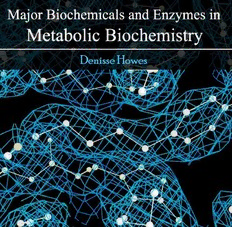
Major biochemicals and enzymes in metabolic biochemistry PDF
Preview Major biochemicals and enzymes in metabolic biochemistry
First Edition, 2012 ISBN 978-81-323-3783-6 © All rights reserved. Published by: University Publications 4735/22 Prakashdeep Bldg, Ansari Road, Darya Ganj, Delhi - 110002 Email: [email protected] Table of Contents Chapter 1 - Glucose Chapter 2 - Fructose Chapter 3 - Glycogen Chapter 4 - Starch Chapter 5 - Pyruvic Acid Chapter 6 - Urea Chapter 7 - Adenosine Triphosphate Chapter 8 - Other Biochemicals and Enzymes in Metabolic Biochemistry Chapter- 1 Glucose D-glucose D-glucopyranose Chain form Ball and stick model Fischer projection of the chain form Preferred IUPAC name Dextrose Systematic name (2R,3S,4R,5R)-2,3,5,4,6-Pentahydroxyhexanal Other names Blood sugar Corn sugar D-Glucose Grape sugar Identifiers Abbreviations Glc CAS number 50-99-7 PubChem 5793 ChemSpider 5589 UNII 5SL0G7R0OK EC number 200-075-1 KEGG C00031 MeSH Glucose ChEBI CHEBI:4167 ChEMBL CHEMBL1216 RTECS number LZ6600000 ATC code B05CX01,V04CA02, V06DC01 Beilstein Reference 1281604 Gmelin Reference 83256 3DMet B04623 Properties Molecular formula C H O 6 12 6 Molar mass 180.16 g/mol Exact mass 180.063388 Density 1.54 g/cm3 α-D-glucose: 146 °C Melting point β-D-glucose: 150 °C Solubility in water 91 g/100 ml (25 °C) Solubility in methanol 0.037 M Solubility in ethanol 0.006 M Solubility in tetrahydrofuran 0.016 M Thermochemistry Std enthalpy of −1271 kJ/mol formation ΔHo f 298 Std enthalpy of −2805 kJ/mol combustion Δ Ho c 298 Standard molar 209.2 J K−1 mol−1 entropy So 298 Hazards MSDS ICSC 0865 D-glucose or dextrose or grape sugar is the dextro-isomer of glucose (C H O ). The 6 12 6 molecule is the mirror-image of L-glucose. D-glucose is a simple sugar (monosaccharide) and an important carbohydrate in biology. Cells use it as a source of energy and a metabolic intermediate. Glucose is one of the main products of photosynthesis and starts cellular respiration. Starch and cellulose are polymers derived from the dehydration of glucose. The name "glucose" comes from the Greek word glukus (γλυκύς), meaning "sweet". The suffix "-ose" denotes a sugar. Glucose exists in several different structures, but all of these structures can be divided into two families of mirror-images (stereoisomers). Only one set of these isomers exists in nature, those derived from the "right-handed form" of glucose, denoted D-glucose. D- glucose is often referred to as dextrose. The term dextrose is derived from dextrorotatory glucose. Solutions of dextrose rotate polarized light to the right (in Latin: dexter = "right" ). Structure Although it is called a "simple sugar" (meaning that it is a monosaccharide), glucose is a complicated molecule because it adopts several different structures. These structures are usually discussed in the context of the acyclic isomer, which exists in only minor amounts in solution. Glucose is derived from hexanal, a chain of six carbon atoms terminating with an aldehyde group. The other five carbon atoms each bear alcohol groups. Glucose is called an aldohexose. In solution, glucose mainly exists as the six-membered ring containing a hemiacetal group, which arises from the reaction of the hydroxy group at C-5 and the aldehyde at C-1. Containing five carbon atoms and one oxygen atom, this ring is a derivative of pyran. This cyclic form of glucose is called a glucopyranose, of which two isomers exist. The asymmetric center at C-1, the site of the hemiacetal, is called the anomeric carbon atom. The ring closing process can give rise to two isomers, called anomers, which are labeled α-glucose and β-glucose. These anomers differ in terms of the relative positioning of the hydroxyl group linked to C-1. When D-glucose is drawn as a Haworth projection or in the standard chain conformation, the designation α means that the hydroxyl group attached to C-1 is positioned trans to the -CH OH group at C-5, while β means that it is 2 cis. An inaccurate but superficially attractive alternative method of distinguishing α from β is observing whether the C-1 hydroxyl is below or above the plane of the ring; this may fail if the glucose ring is drawn upside down or in an alternative chair conformation. The α and β forms interconvert over a timescale of hours in aqueous solution, to a final stable ratio of α:β 36:64, in a process called mutarotation. The ratio would be α:β 11:89 if it were not for the influence of the anomeric effect. Isomers Aldohexoses have four chiral centers in their acyclic forms (i.e. ignoring the anomeric carbon). Four chiral centers give rise to 24 = 16 stereoisomers. These stereoisomers are classified into two classes with eight sugars in each, which are mirror images of each other. One class is labeled L and the other D. Only seven of these isomers are found in nature, of which D-glucose (Glu), D-galactose (Gal) and D-mannose (Man) are the most important. These eight isomers (including glucose itself) are diastereoisomers and belong to the D series. The Fischer projection of the chain form of D-glucose The chain form of D-glucose α-D- glucopyranose β-D- glucopyranose Chain form: ball-and-stick model Chain form: space-filling model
